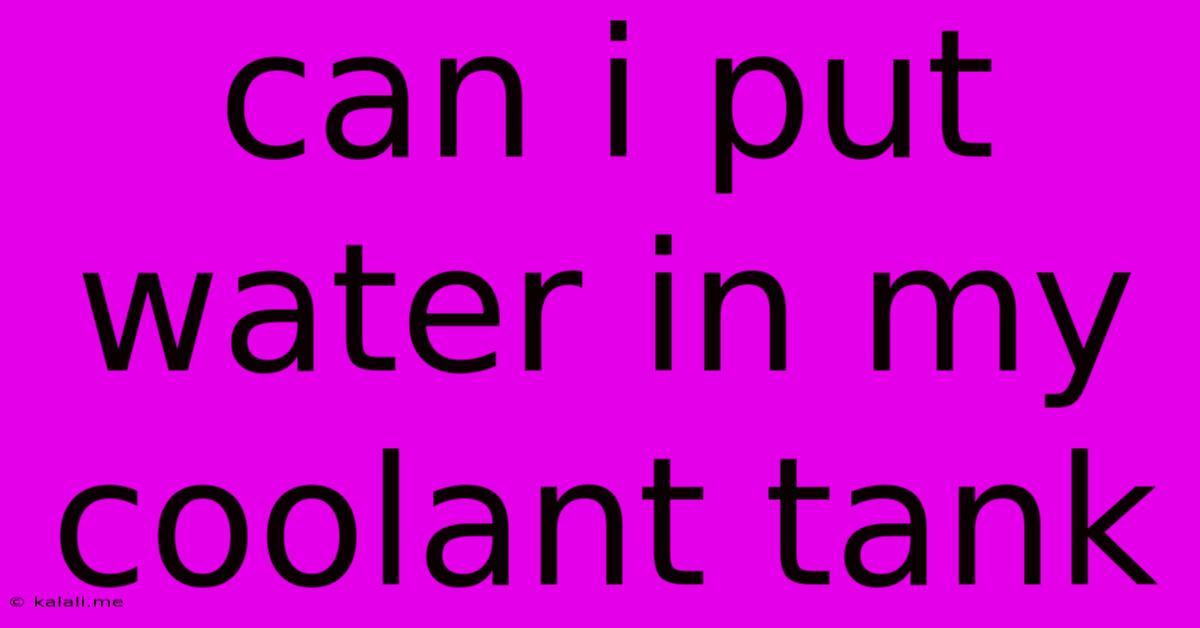Can I Put Water In My Coolant Tank
Kalali
May 20, 2025 · 3 min read

Table of Contents
Can I Put Water in My Coolant Tank? A Comprehensive Guide
Meta Description: Wondering if you can just add water to your coolant tank? Find out the risks and benefits of using water vs. coolant, and learn the best practices for maintaining your vehicle's cooling system. This comprehensive guide clarifies when water is acceptable and when it's a dangerous gamble.
Adding water to your car's coolant tank might seem like a quick fix when your coolant level is low, but it's a decision that should be approached with caution. While a small amount of water in a pinch might not cause immediate harm, relying solely on water or consistently mixing water with coolant can severely damage your engine. This article will explore the implications of adding water to your coolant tank, outlining the risks and when it might be a marginally acceptable temporary solution.
Understanding the Role of Coolant
Coolant, also known as antifreeze, is far more than just water. It's a carefully formulated mixture of water and chemicals designed to perform several critical functions:
- Cooling: The primary function is to absorb heat from the engine block and prevent overheating.
- Corrosion Prevention: Coolant contains inhibitors that protect engine components from rust and corrosion.
- Lubrication: It lubricates the water pump and other parts within the cooling system.
- Freezing Point Depression: The antifreeze component lowers the freezing point of the mixture, preventing damage during winter.
- Boiling Point Elevation: It raises the boiling point, preventing the coolant from boiling over during hot operation.
The Dangers of Using Only Water
Using only water in your cooling system poses several significant risks:
- Overheating: Water boils at a much lower temperature than coolant, making your engine far more susceptible to overheating, which can lead to severe engine damage including warped cylinder heads, cracked engine blocks, and blown head gaskets. These repairs are costly and often necessitate major engine work.
- Corrosion: Without the corrosion inhibitors present in coolant, your engine components are vulnerable to rapid rust and corrosion, leading to leaks, reduced efficiency, and eventual failure.
- Freezing Damage: In freezing temperatures, water expands as it freezes, potentially cracking engine blocks and other parts of the cooling system. This damage can be catastrophic.
- Scale Buildup: Water can leave mineral deposits (scale) inside the engine block and radiator, restricting coolant flow and leading to overheating.
When is Adding Water Acceptable? (With Huge Caveats!)
There are extremely limited circumstances where adding a small amount of water might be a temporary measure only until you can obtain proper coolant:
- Emergency Situations: If you're stranded with a low coolant level and absolutely cannot source coolant immediately, adding a small amount of clean water can buy you some time to get to a repair shop or parts store. This is a last resort, not a regular practice.
- Top-Up Before a Coolant Change: Some mechanics might suggest topping up with water immediately before a complete coolant flush and replacement. This allows the old, potentially contaminated coolant to be flushed more effectively, but only in conjunction with a full system replacement.
Best Practices for Coolant Maintenance
- Regular Inspections: Check your coolant level regularly – usually there's a translucent reservoir that makes this easy.
- Use the Correct Coolant: Use the type of coolant recommended by your vehicle manufacturer. Mixing different types of coolant can lead to problems.
- Professional Flushes: Get your cooling system professionally flushed and refilled every few years to prevent the buildup of contaminants.
Conclusion
While adding a small amount of water to your coolant tank might seem like an inconsequential act in a dire situation, it’s crucial to remember that coolant is a specialized fluid designed to protect your engine. Regular coolant maintenance, using the correct fluid, and avoiding the habitual use of water are essential for maintaining the health and longevity of your vehicle's cooling system and preventing costly repairs. Always prioritize using the proper coolant; water is a temporary emergency measure, not a long-term solution.
Latest Posts
Latest Posts
-
Till What Time Can I Pray Fajr
May 20, 2025
-
How To Call To Italy From Uk
May 20, 2025
-
Why Does My Boiler Fire Up In The Night
May 20, 2025
-
Difference Between Ba Degree And Bs Degree
May 20, 2025
-
Rear End Clunking Noise When Going Over Bumps
May 20, 2025
Related Post
Thank you for visiting our website which covers about Can I Put Water In My Coolant Tank . We hope the information provided has been useful to you. Feel free to contact us if you have any questions or need further assistance. See you next time and don't miss to bookmark.